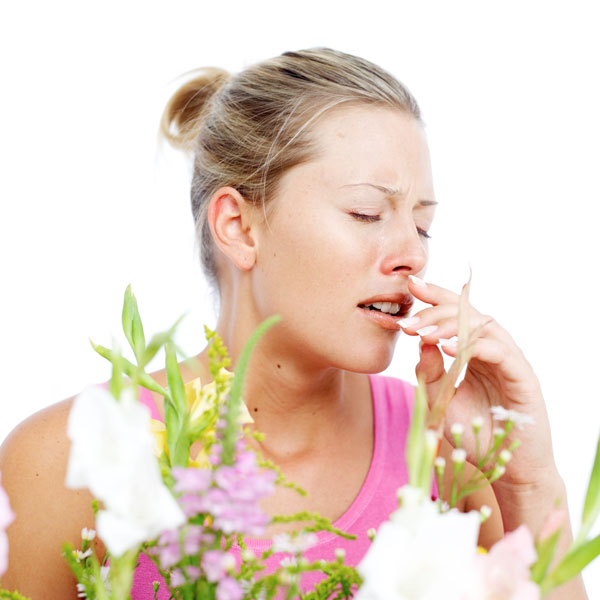While most of us are celebrating the arrival of the warm weather and looking forward to spending time outdoors in the sunshine, there’s one group of people for whom this time of year is not a lot of fun. They suffer from hay fever, and pollen-filled air can make their lives a misery.But you don’t need to just put up with it – help is at hand.
15 things you need to know about hay fever
1.Hay fever is a type of allergic rhinitis – an allergic condition that affects the nose, throat and eyes. Seasonal allergic rhinitis (hay fever) is caused by a reaction to pollen and mould spores and usually occurs in spring and summer.
2.When you have hay fever, your body mistakenly thinks substances like pollen are harmful and your immune system responds by producing antibodies to fight them. The next time you come into contact with the same substance, your body recognises the allergens as bad guys and releases chemicals called histamines into your bloodstream to deal with them. It’s these chemicals that cause an over-reaction and lead to symptoms such as sneezing and streaming eyes.
3.Common seasonal hay fever triggers include:
Tree pollen, usually found in spring.
Weed pollen, found in autumn.
Grass pollen, which is common in late spring and summer.
Spores from fungi and moulds, which can be worse when in warm weather.
These allergens (substances that cause allergies) are present in the air and startcausing problems for you after you breathe them in.
4.The symptoms of hay fever usually appear straight after you’ve been exposed to allergens. They include:
Runny or blocked-up nose.
Itchy or watery eyes.
Sneezing.
Coughing.
Itchy throat or nose.
Pressure on your sinuses and pain in your face due to sinusitis.
Dark circles and swollen skin under your eyes.
- You can get allergic rhinitis all year round. Year-round triggers include:
Pet dander (dried skin flakes and saliva). This comes from domestic animals such as cats and dogs.
Dust mites.
Spores from fungi and moulds, both indoors and out.
6.It’s easy to confuse hay fever symptoms with a cold. It’s more likely to be an allergy than a cold if:
You have a watery discharge when you blow your nose, rather than the thick yellow one you tend to get with a cold.
You don’t have a temperature. A low grade fever often accompanies a cold.
You notice symptoms immediately after being exposed to allergens like grass or tree pollen.
Your symptoms last as long as you’re in contact with triggers like pollen. A cold usually runs its course after a week or so.
7.You may be more likely to suffer from hay fever if you:
Have a family history of allergies.
Were exposed to cigarette smoke as a baby.
Were exposed to dust mites as a child.
Are male.
Were the first child born in your family.
Were born during pollen season.
8.If you suffer from hay fever, you may also have:
Asthma. Symptoms of this may include difficulty breathing, shortness of breath, coughing, wheezing and a tight feeling in your chest.
Eczema. This condition results in swollen, red or itchy skin. It’s also called dermatitis.
Sinusitis, which is an infection or inflammation of the lining of the sinuses.
9.To find out exactly what is causing your hay fever, your doctor may suggest carrying out blood or skin tests. Hay fever can’t be cured but you may be able to keep symptoms at bay by avoiding things that trigger your condition.
10.In some cases, hay fever can lead to complications. These can include:
Bacterial infections such as ear or sinus infections.
Nosebleeds.
Decreased lung function.
Facial swelling and dark circles under the eyes.
11.Treatments for hay fever depend on how severe your symptoms are and include:
Antihistamines to counter the effects of histamines in your blood.
Nasal sprays to clear a stuffy nose.
Decongestants to ease congestion.
other medications, including corticosteroids.
If medication doesn’t work, your doctor may suggest immunotherapy, which involves controlled exposure to the allergens that trigger your hay fever. The idea is that this will help to make you less sensitive to them.
12.Some people swear by alternative therapies to keep their hay fever symptoms at bay. Garlic and horseradish are also supposed to be good for hay fever symptoms.
13.Some allergy medications can have side effects such as leaving a bad taste in your mouth, raising blood pressure, sore throat and headaches. Let your doctor know if you have any problems with medications.
14. Hay fever can begin at any age, although it typically starts in childhood or early adulthood. The severity of symptoms sometimes decreases as you get older.
15About 20% of Kiwis suffer from hay fever. It tends to be regarded as a nuisance rather than a major illness, but it can have a huge impact on some people’s lives, confining them indoors or making it difficult for them to sleep.
DID YoU KNoW? Hay fever is almost never triggered by hay – and it doesn’t cause a fever! Pollen from flowers is a common trigger for hay fever




